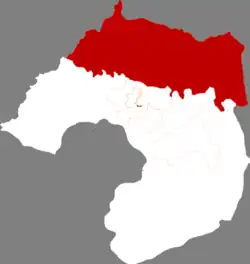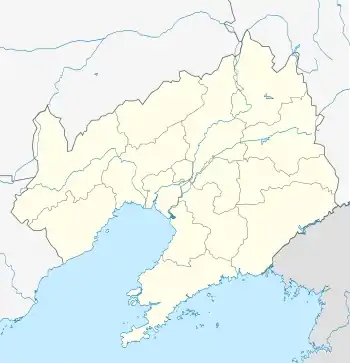Dengta
灯塔市 | |
|---|---|
 Location in Liaoyang | |
 Dengta Location in Liaoning | |
| Coordinates: 41°26′N 123°20′E / 41.433°N 123.333°E | |
| Country | People's Republic of China |
| Province | Liaoning |
| Prefecture-level city | Liaoyang |
| Area | |
| • County-level city | 1,166.0 km2 (450.2 sq mi) |
| • Urban | 127.00 km2 (49.03 sq mi) |
| Elevation | 44 m (143 ft) |
| Population (2017)[1] | |
| • County-level city | 442,000 |
| • Density | 380/km2 (980/sq mi) |
| • Urban | 109,600 |
| Time zone | UTC+8 (China Standard) |
Dengta (simplified Chinese: 灯塔; traditional Chinese: 燈塔; pinyin: Dēngtǎ; lit. 'Lighthouse') is a city in east-central Liaoning province in Northeast China. It is located in between Liaoyang, which oversees Dengta and lies 22 kilometers (14 mi) to the southwest, and Shenyang, the provincial capital which lies nearly double that distance to the northeast.
Administrative Divisions
There are three subdistricts, 12 towns and one township under the city's administration.[2]
Subdistricts:
- Wanbaoqiao Subdistrict (万宝桥街道), Yantai Subdistrict (烟台街道), Gucheng Subdistrict (古城街道)
Towns:
- Dengta Town (灯塔镇), Huazi (铧子镇), Zhangtaizi (张台子镇), Xidayao (西大窑镇), Tong'erpu (佟二堡镇), Shendanbao (沈旦堡镇), Liutiaozhai (柳条寨镇), Ximafeng (西马峰镇), Wangjia (王家镇), Liuhezi (柳河子镇), Luodatai (罗大台镇), Dahenan (大河南镇)
The only township is Jiguanshan Township (鸡冠山乡)
Climate
| Climate data for Dengta (1991–2020 normals) | |||||||||||||
|---|---|---|---|---|---|---|---|---|---|---|---|---|---|
| Month | Jan | Feb | Mar | Apr | May | Jun | Jul | Aug | Sep | Oct | Nov | Dec | Year |
| Mean daily maximum °C (°F) | −4.3 (24.3) |
0.5 (32.9) |
7.7 (45.9) |
17.1 (62.8) |
24.1 (75.4) |
27.6 (81.7) |
29.5 (85.1) |
28.8 (83.8) |
24.6 (76.3) |
16.7 (62.1) |
6.3 (43.3) |
−1.9 (28.6) |
14.7 (58.5) |
| Daily mean °C (°F) | −10.5 (13.1) |
−5.5 (22.1) |
2.1 (35.8) |
11.0 (51.8) |
18.1 (64.6) |
22.5 (72.5) |
25.0 (77.0) |
23.9 (75.0) |
18.2 (64.8) |
10.4 (50.7) |
1.0 (33.8) |
−7.4 (18.7) |
9.1 (48.3) |
| Mean daily minimum °C (°F) | −15.7 (3.7) |
−10.7 (12.7) |
−2.9 (26.8) |
5.0 (41.0) |
12.2 (54.0) |
17.6 (63.7) |
20.9 (69.6) |
19.7 (67.5) |
12.9 (55.2) |
5.1 (41.2) |
−3.5 (25.7) |
−12.1 (10.2) |
4.0 (39.3) |
| Average precipitation mm (inches) | 5.8 (0.23) |
9.1 (0.36) |
15.6 (0.61) |
34.9 (1.37) |
60.8 (2.39) |
92.3 (3.63) |
170.3 (6.70) |
154.3 (6.07) |
60.4 (2.38) |
45.7 (1.80) |
23.9 (0.94) |
11.1 (0.44) |
684.2 (26.92) |
| Average precipitation days (≥ 0.1 mm) | 3.4 | 3.4 | 4.6 | 6.8 | 9.2 | 11.3 | 11.6 | 11.2 | 7.0 | 6.6 | 5.3 | 4.4 | 84.8 |
| Average snowy days | 5.6 | 4.6 | 3.9 | 1.2 | 0 | 0 | 0 | 0 | 0 | 0.5 | 4.2 | 5.6 | 25.6 |
| Average relative humidity (%) | 62 | 56 | 53 | 50 | 54 | 67 | 78 | 81 | 72 | 65 | 64 | 64 | 64 |
| Mean monthly sunshine hours | 182.2 | 193.6 | 230.8 | 230.1 | 255.6 | 226.2 | 197.5 | 208.2 | 227.2 | 206.7 | 166.6 | 163.6 | 2,488.3 |
| Percent possible sunshine | 61 | 64 | 62 | 57 | 57 | 50 | 43 | 49 | 61 | 61 | 57 | 58 | 57 |
| Source: China Meteorological Administration[3][4] | |||||||||||||
References
- 1 2 Ministry of Housing and Urban-Rural Development, ed. (2019). China Urban Construction Statistical Yearbook 2017. Beijing: China Statistics Press. p. 50. Retrieved 11 January 2020.
- ↑ 辽阳市-行政区划网
- ↑ 中国气象数据网 – WeatherBk Data (in Simplified Chinese). China Meteorological Administration. Retrieved 28 April 2023.
- ↑ 中国气象数据网 (in Simplified Chinese). China Meteorological Administration. Retrieved 28 April 2023.
External links
This article is issued from Wikipedia. The text is licensed under Creative Commons - Attribution - Sharealike. Additional terms may apply for the media files.